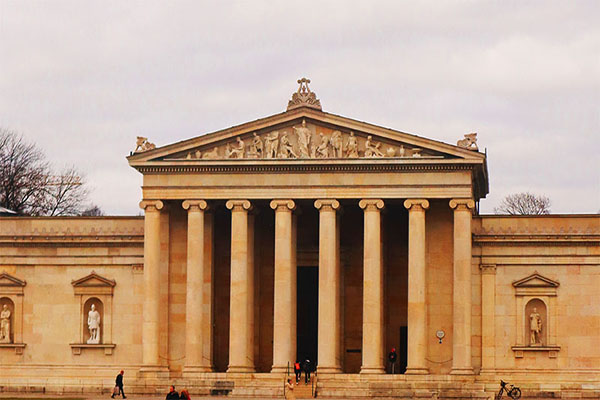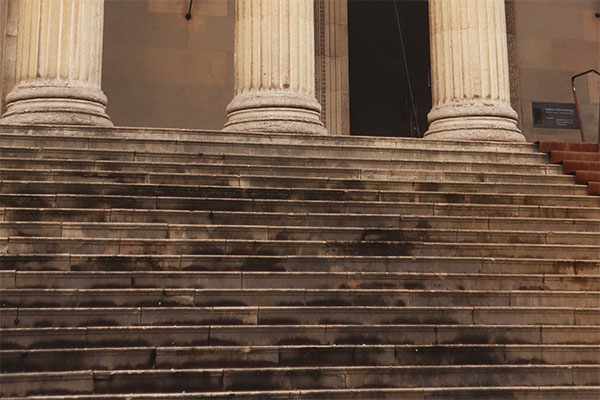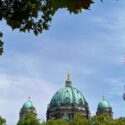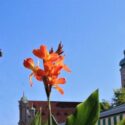The Glyptothek in Munich is dedicated to ancient sculptures and was constructed between 1816 and 1830 and is the oldest public museum in Munich. It is a place where Greek and Roman sculptures are gathered in an exhibition that moves in a clockwise fashion around wide corridors with high ceilings. To visit the Glyptothek is a treat, no less because of the living art that exists there daily. As I visit the Glyptothek in Munich early in the year I am joined by a group of students, sitting on foldable chairs and sketching. The sounds of their pencils drawing long lines or shadows on huge sheets of white paper is deafening. Because everything else in the Glyptothek is silent. People move silently between the rooms, hushed voices can barely be heard. I circle the practicing artists to find angles from which to look at the Greek sculptures while being aware of the building’s design as a long quadratic corridor that stretches around along the walls, with an open courtyard in the middle.
As I walk around the exhibitions, I get to partake in a short adventure spanning the lifetimes of people of the ancient Greek and Roman world. The hands that molded these sculptures lived in one of several epochs; the Archaic period, the Classical period, the Hellenistic period, and the Roman period. With this in mind, I grow more silent as I glide between sculptures, careful not to interrupt the students and the jagged sounds of their pencils. This is a treat and I have looked forward to it for years.
What did they talk about when sculpting?
There are times that I come to a full stop and then time slows down for a moment, such as when the lines of Plato's sculpted face catch the light from the large windows and I am certain that whoever sculpted this would have made for a great conversation partner. And I wonder, what did they talk about as the sculpting progressed? Was Plato bored at the time or as serene as the sculpture wants me to believe? Did he have to be told to assume his serene expression?
3D artists in ancient times
The sculptors of the ancient world knew the human form just as well as any modern-age 3D character designer does, I guess, as I recall how sculpting evolved from archaic times and how the poses have significance. They go far beyond just catching the light in a certain way. And our light from our sun that seeps in through the large windows in the Glyptothek was the same sun that those sculptors had as they searched shadows and carefully molded these sculptures. It is the same sun that probably made the depicted people sweat on a hot day (it was the Mediterranean region after all). They lived and were trapped in political and technological realities. There were everyday concerns and joys, then just like now.
To think that two thousand years later, I would get the chance to look at these pieces of art, into the lifelike faces, and almost expect them to move, maybe to sneeze or turn to gaze back at me just like I gaze at them. To think that human lifespans have been frozen at particular times, showing the age and wrinkles of men and women, clothing, and accessories. For a moment I feel as if my imagination can transport me back in time, and I would expect to hear the voices of ancient Greek or Latin. But I snap back into the year 2023 on a warm January day in Munich. This is the Glyptothek and it is safekeeping sculptures from ancient times. For those who can and want to look beyond the sculptures, to grasp at the society context they were created, it is possible to leave the museum with a slightly increased understanding of some artistic minds and their reality in the ancient Mediterranean world.
One foot forward or both feet in parallel
Take your time and circle the statues a couple if not more times. Take in the details of the carved facial expressions and the carefully orchestrated postures. Each has a story to tell and from every angle, the statues seem to utter different truths, revealing something slightly different about themselves. Hints of the artist’s reality, and their influence on and by society back then. Whether a foot is shot forward or the sculpture is standing erect and straight, or the shoulders are slanting just a bit. How the angle of the head tells a story, and the sculpted cloth draped over a shoulder, a chest armor closely following the outline of the torso. These are more than mere accidental details. Postures have a meaning, whether a statue is looking straight ahead or to the side.
I perceive that time slows down
But time does not come to a full stop. It continues relentlessly forward. As I behold the sculptures of people from millennia past, each is presented against a backdrop of historical events. Every stance of every sculpture beckons me to understand just a bit more, should I want to with the discretely placed information signs in each room of the exhibition. I do want to understand but at the same time it is overwhelming to know how much information lies hidden, and how much is not told with this selection of statues.
It is difficult not to become emotional in a place like the Glyptothek if one has the slightest interest in history and art. The building itself is architected so that the sheer scale of the place creates a sense of excitement for what is to come. Just like the hands of a clock, the exhibition in this museum turns clockwise. Just like time passes slower, so do I circle clockwise around the museum.
Among art and art students
The scratching sounds of the pencils do not stop. Students are seated on footstools in front of statues, sketching their view of the ancient art in front of them. They pull me back to reality and I am careful not to linger too long in front of them, not to obstruct their view. The occasional student will walk between statues and sit down again to sketch. I watch. I switch between watching the sculptures from different angles to throwing glances at the hunched-over students. I listen to the sounds of pencils scratching away at the paper, as they capture a visual representation of sculptures by minds in our time. The scratching sounds are those of attempts to depict artists’ views of humans more than a thousand years ago, molded in rock for our entertainment to look at. The fact that the low sounds of scratching pencils on paper can be heard in a place like this is a mighty impressive experience.
+1000 years expressed with art
The Archaic period in Greece per definition begins around 800 BC according to one agreed timeline by scholars. The Roman era ends in 550 AD. So this Neoclassical building houses glimpses, and selections, of some 900 years of human art. There is no full picture of everything ancient in the Glyptothek. But that is not necessary. The exhibitions as a whole form a piece of art themselves, set in a building that was once made completely out of marble and designed in the classical Greek-Italian style. The portico is Ionic and the walls are set with 18 original sculptures from Greek and Roman times. If that is not a silent welcome to any passer-by who likes art, then the same would be hard to please. As I force myself to leave to fully let the impressions of the sculptures and of the building itself sink in, I know that this may very well be a highlight for many road trips to come, and for countless travelers. I leave the museum, time again speeding up to the normal tick tock which we are all bound by in our everyday lives. But as I look back at the Glyptothek and the sculptures, I would like to believe that time will slow down with the same enjoyable effect for other visitors as they dream away in the corridors of the Glyptothek. The door close behind me and 18 sculptures are frozen solemnly on the building’s exterior beckoning for others to visit.






